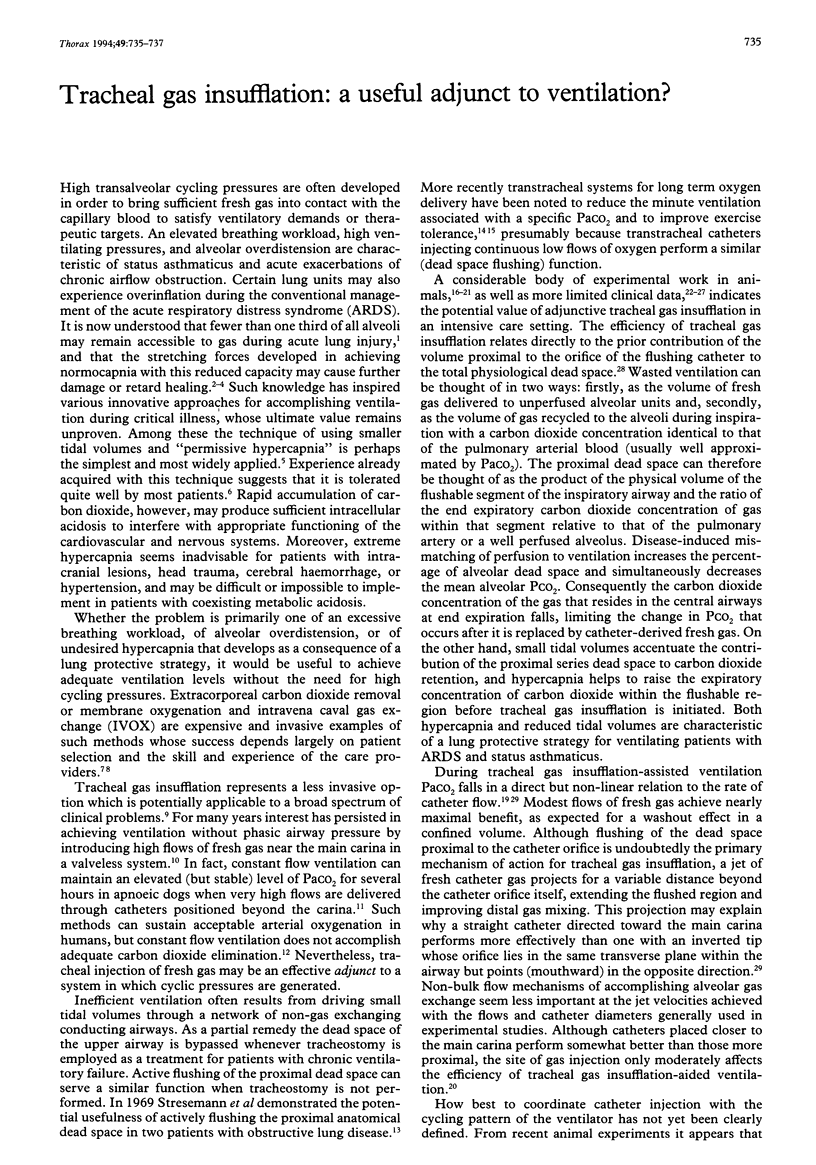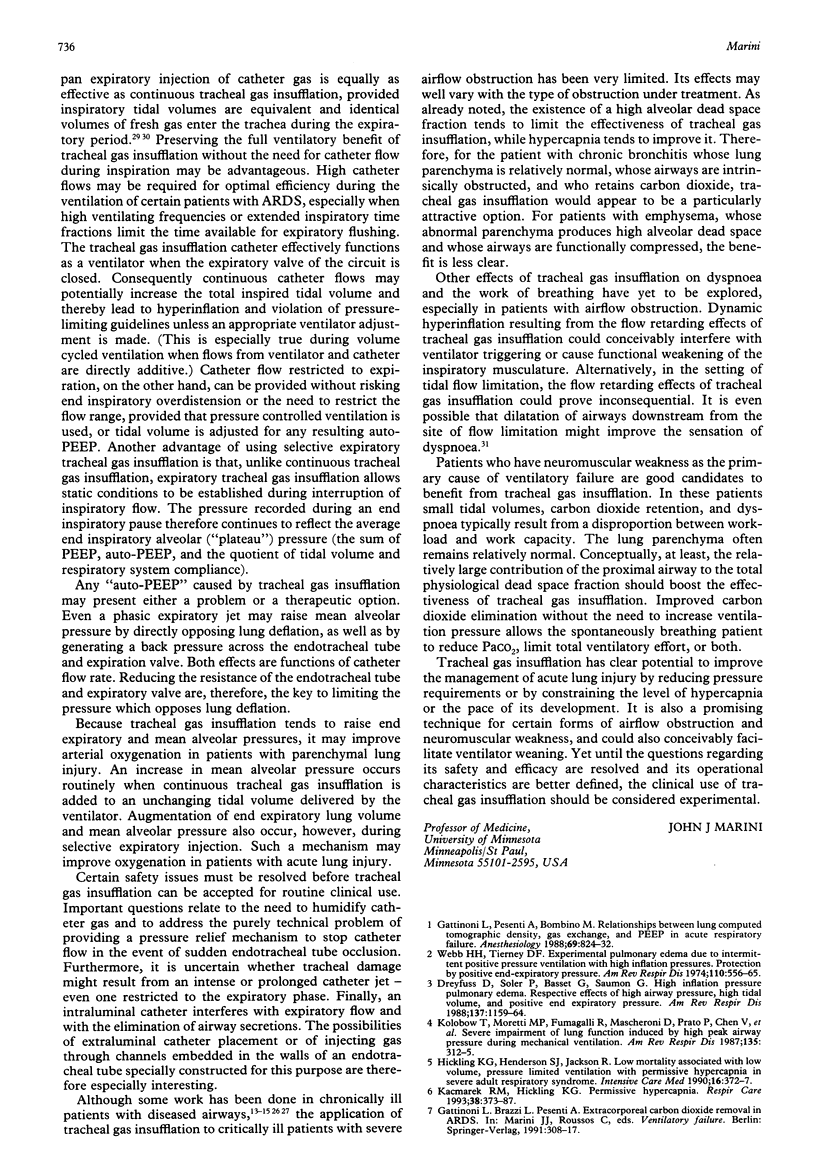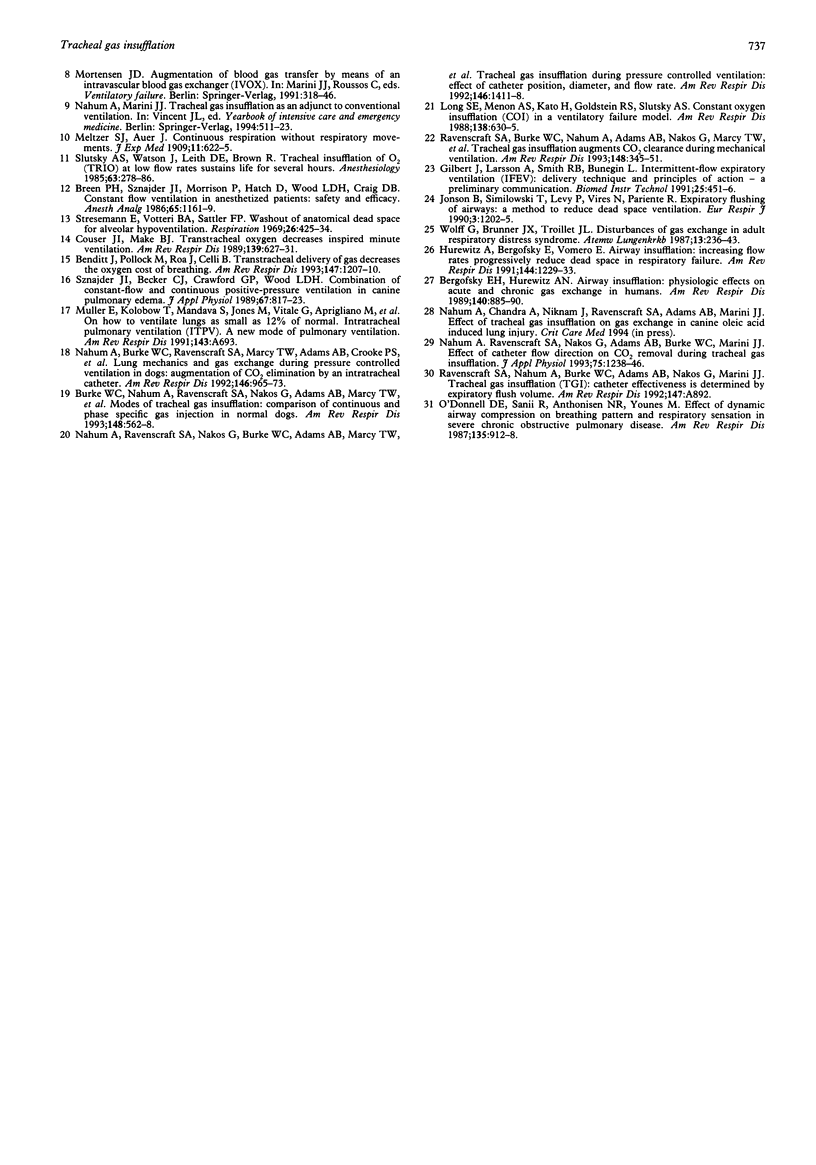Full text
PDF


Selected References
These references are in PubMed. This may not be the complete list of references from this article.
- Benditt J., Pollock M., Roa J., Celli B. Transtracheal delivery of gas decreases the oxygen cost of breathing. Am Rev Respir Dis. 1993 May;147(5):1207–1210. doi: 10.1164/ajrccm/147.5.1207. [DOI] [PubMed] [Google Scholar]
- Bergofsky E. H., Hurewitz A. N. Airway insufflation: physiologic effects on acute and chronic gas exchange in humans. Am Rev Respir Dis. 1989 Oct;140(4):885–890. doi: 10.1164/ajrccm/140.4.885. [DOI] [PubMed] [Google Scholar]
- Breen P. H., Sznajder J. I., Morrison P., Hatch D., Wood L. D., Craig D. B. Constant flow ventilation in anesthetized patients: efficacy and safety. Anesth Analg. 1986 Nov;65(11):1161–1169. [PubMed] [Google Scholar]
- Burke W. C., Nahum A., Ravenscraft S. A., Nakos G., Adams A. B., Marcy T. W., Marini J. J. Modes of tracheal gas insufflation. Comparison of continuous and phase-specific gas injection in normal dogs. Am Rev Respir Dis. 1993 Sep;148(3):562–568. doi: 10.1164/ajrccm/148.3.562. [DOI] [PubMed] [Google Scholar]
- Couser J. I., Jr, Make B. J. Transtracheal oxygen decreases inspired minute ventilation. Am Rev Respir Dis. 1989 Mar;139(3):627–631. doi: 10.1164/ajrccm/139.3.627. [DOI] [PubMed] [Google Scholar]
- Gattinoni L., Pesenti A., Bombino M., Baglioni S., Rivolta M., Rossi F., Rossi G., Fumagalli R., Marcolin R., Mascheroni D. Relationships between lung computed tomographic density, gas exchange, and PEEP in acute respiratory failure. Anesthesiology. 1988 Dec;69(6):824–832. doi: 10.1097/00000542-198812000-00005. [DOI] [PubMed] [Google Scholar]
- Gilbert J., Larsson A., Smith R. B., Bunegin L. Intermittent-flow expiratory ventilation (IFEV): delivery technique and principles of action--a preliminary communication. Biomed Instrum Technol. 1991 Nov-Dec;25(6):451–456. [PubMed] [Google Scholar]
- Harrison R. A., Wong L. B., Yeates D. B. Short-term interaction of airway and tissue oxygen tensions on ciliary beat frequency in dogs. Am Rev Respir Dis. 1992 Jul;146(1):141–147. doi: 10.1164/ajrccm/146.1.141. [DOI] [PubMed] [Google Scholar]
- Hickling K. G., Henderson S. J., Jackson R. Low mortality associated with low volume pressure limited ventilation with permissive hypercapnia in severe adult respiratory distress syndrome. Intensive Care Med. 1990;16(6):372–377. doi: 10.1007/BF01735174. [DOI] [PubMed] [Google Scholar]
- Hurewitz A. N., Bergofsky E. H., Vomero E. Airway insufflation. Increasing flow rates progressively reduce dead space in respiratory failure. Am Rev Respir Dis. 1991 Dec;144(6):1229–1233. doi: 10.1164/ajrccm/144.6.1229. [DOI] [PubMed] [Google Scholar]
- Jonson B., Similowski T., Levy P., Viires N., Pariente R. Expiratory flushing of airways: a method to reduce deadspace ventilation. Eur Respir J. 1990 Nov;3(10):1202–1205. [PubMed] [Google Scholar]
- Kolobow T., Moretti M. P., Fumagalli R., Mascheroni D., Prato P., Chen V., Joris M. Severe impairment in lung function induced by high peak airway pressure during mechanical ventilation. An experimental study. Am Rev Respir Dis. 1987 Feb;135(2):312–315. doi: 10.1164/arrd.1987.135.2.312. [DOI] [PubMed] [Google Scholar]
- Long S. E., Menon A. S., Kato H., Goldstein R. S., Slutsky A. S. Constant oxygen insufflation (COI) in a ventilatory failure model. Am Rev Respir Dis. 1988 Sep;138(3):630–635. doi: 10.1164/ajrccm/138.3.630. [DOI] [PubMed] [Google Scholar]
- Nahum A., Burke W. C., Ravenscraft S. A., Marcy T. W., Adams A. B., Crooke P. S., Marini J. J. Lung mechanics and gas exchange during pressure-control ventilation in dogs. Augmentation of CO2 elimination by an intratracheal catheter. Am Rev Respir Dis. 1992 Oct;146(4):965–973. doi: 10.1164/ajrccm/146.4.965. [DOI] [PubMed] [Google Scholar]
- Nahum A., Ravenscraft S. A., Nakos G., Adams A. B., Burke W. C., Marini J. J. Effect of catheter flow direction on CO2 removal during tracheal gas insufflation in dogs. J Appl Physiol (1985) 1993 Sep;75(3):1238–1246. doi: 10.1152/jappl.1993.75.3.1238. [DOI] [PubMed] [Google Scholar]
- O'Donnell D. E., Sanii R., Anthonisen N. R., Younes M. Effect of dynamic airway compression on breathing pattern and respiratory sensation in severe chronic obstructive pulmonary disease. Am Rev Respir Dis. 1987 Apr;135(4):912–918. doi: 10.1164/arrd.1987.135.4.912. [DOI] [PubMed] [Google Scholar]
- Ravenscraft S. A., Burke W. C., Nahum A., Adams A. B., Nakos G., Marcy T. W., Marini J. J. Tracheal gas insufflation augments CO2 clearance during mechanical ventilation. Am Rev Respir Dis. 1993 Aug;148(2):345–351. doi: 10.1164/ajrccm/148.2.345. [DOI] [PubMed] [Google Scholar]
- Slutsky A. S., Watson J., Leith D. E., Brown R. Tracheal insufflation of O2 (TRIO) at low flow rates sustains life for several hours. Anesthesiology. 1985 Sep;63(3):278–286. doi: 10.1097/00000542-198509000-00007. [DOI] [PubMed] [Google Scholar]
- Sznajder J. I., Becker C. J., Crawford G. P., Wood L. D. Combination of constant-flow and continuous positive-pressure ventilation in canine pulmonary edema. J Appl Physiol (1985) 1989 Aug;67(2):817–823. doi: 10.1152/jappl.1989.67.2.817. [DOI] [PubMed] [Google Scholar]
- Webb H. H., Tierney D. F. Experimental pulmonary edema due to intermittent positive pressure ventilation with high inflation pressures. Protection by positive end-expiratory pressure. Am Rev Respir Dis. 1974 Nov;110(5):556–565. doi: 10.1164/arrd.1974.110.5.556. [DOI] [PubMed] [Google Scholar]


